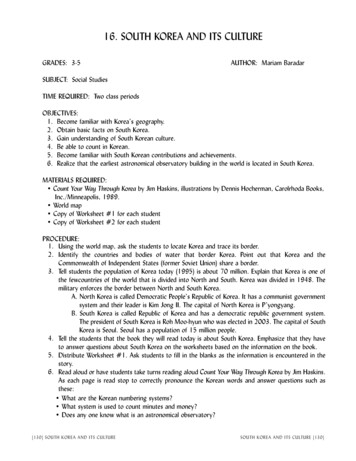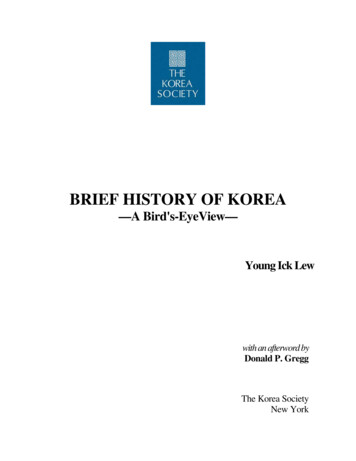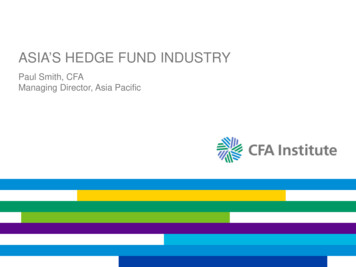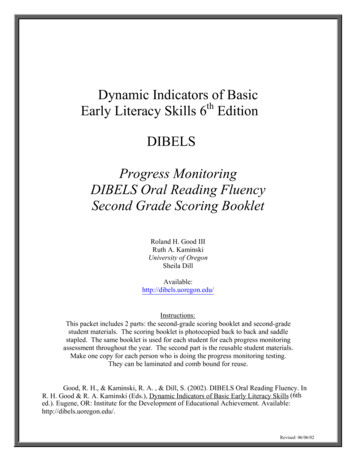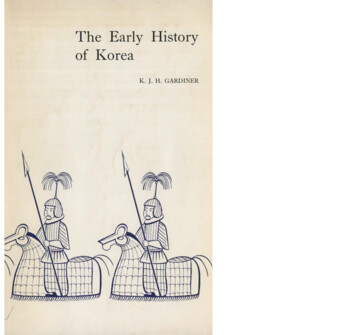
Transcription
The Early Historyof KoreaK. J. H. GARDINERKorean studies in Western univer sities have long been hampered by theabsence of an adequate general historyof Korea in any Western language.The earliest period of Korean history,up to the introduction of Buddhismlate in the fourth century a.d ., remainsthe worst served of any.This short history is intended as anattempt to remedy the situation. It isbased mostly upon studies alreadycarried out by Korean and Japanesescholars, and aims at making some ofthe results of their research available toWestern students, particularly studentsof Chinese and Japanese history.Dr Gardiner writes about the back ground and history of Korea beforethe Han conquest in 108 b .c .; thestructure and development of theChinese colonies in Korea from 108b .c . to the end of the third centurya .d . ; the early history of Koguryö, laterone of the ‘Three Kingdoms’ of Korea;and finally about the conditions whichproduced so many changes in Koreain the fourth century A.D., includingthe beginning of Japanese interventionand the coming of Buddhism.The front cover shows a group o f arm oured horsemen from a fresco in the tombo f Tung Shou, 4th century A .D . (seefrontispiece). A3.50
The Early Historyof KoreaK. J. H. GARDINERKorean studies in Western univer sities have long been hampered by theabsence of an adequate general historyof Korea in any Western language.The earliest period of Korean history,up to the introduction of Buddhismlate in the fourth century a.d ., remainsthe worst served of any.This short history is intended as anattempt to remedy the situation. It isbased mostly upon studies alreadycarried out by Korean and Japanesescholars, and aims at making some ofthe results of their research available toWestern students, particularly studentsof Chinese and Japanese history.Dr Gardiner writes about the back ground and history of Korea beforethe Han conquest in 108 b .c .; thestructure and development of theChinese colonies in Korea from 108b .c . to the end of the third centurya .d . ; the early history of Koguryö, laterone of the ‘Three Kingdoms’ of Korea;and finally about the conditions whichproduced so many changes in Koreain the fourth century A.D., includingthe beginning of Japanese interventionand the coming of Buddhism.The front cover shows a group o f arm oured horsemen from a fresco in the tombo f Tung Shou, 4th century A .D . (seefrontispiece). A3.50
Dr Kenneth Gardiner graduated fromthe School of Oriental and AfricanStudies at London University in 1953.In 1959 he went to Kyoto Universityon a Japanese government scholarshipto study Korean archaeology, returningto London University in 1961. Hereceived his doctorate from thatuniversity in 1964. Dr Gardiner is nowlecturer in Chinese culture and history,Department of Asian Civilisation,Australian National University, havingcome to Canberra from a teaching postin Tokyo.
This book was published by ANU Press between 1965–1991.This republication is part of the digitisation project being carriedout by Scholarly Information Services/Library and ANU Press.This project aims to make past scholarly works publishedby The Australian National University available toa global audience under its open-access policy.
THE EARLY HISTORY OF KOREAOriental Monograph SeriesNo. 8
The left-hand chamber of the tomb of Tung Shou, as seen from the centralchamber. The seated figure on the further wall is that of Tung Shou himself;the remaining two figures and the inscription are on the side walls of the centralchamber. The drawing is based upon plans and photographs reproduced inAnak Che: Samhobun Palgul Pogo (P’yöng-yang, 1958).
THE EARLYHISTORY OF KOREAThe Historical Developmentof the Peninsula up to the Introduction of Buddhismin the Fourth Century A.D.K. H. J. GARDINER1969Centre of Oriental Studies in association with theAUSTRALIAN NATIONAL UNIVERSITY PRESSCanberra
First published 1969This book is copyright. A part from any fa ir dealing for the purposes of privatestudy, research, criticism, or review, as perm itted under the Copyright Act, nopa rt may be reproduced by any process without written permission. Inquiries shouldbe made to the publisher. Kenneth Herbert James Gardiner 1969SBN 7081 0257 3Library of Congress Catalog Card no. 69-13113National Library of Australia reg. no. AUS 68-2475
PrefaceThe idea of writing this book grew out of work which I originally undertook inconnection with my thesis, ‘The Origin and Rise of the Korean Kingdom ofKoguryö, from the First Century B.c. to 313 a .d .’ (London, 1964). I felt that, inaddition to academic articles with their elaborate apparatus of footnotes andtables, there was a place for an outline of early Korean history which should aimat presenting Sinologists and Japanologists with essential information, and thebibliography necessary to pursue further studies.The author is indebted to Professor J. W. de Jong, Head of the Department ofSouth Asian and Buddhist Studies, and to Professor A. L. Basham, Head of theDepartment of Asian Civilisation, both of the Australian National University,for their encouragement and helpful suggestions. My special thanks must alsogo to Professor F. Vos, Head of the Department of Japanese and Korean atLeiden University, and to Professor K. Arimitsu, Head of the Department ofArchaeology in the Faculty of Arts and Letters, Kyoto University, both of whomread the manuscript and offered a number of corrections and improvements.I should also like to take this opportunity of expressing my gratitude to Mr M.Matsumaru, Research Officer of the Department of Far Eastern History of theAustralian National University, who made a number of extremely helpful sugges tions and comments, particularly in connection with Appendix I, and who alsodrew my attention to a number of recent Japanese studies of the Tung ShouTomb. Mr P. Daniell, of the Department of Geography, School of GeneralStudies, Australian National University, cheerfully undertook the task of makingcartographical sense out of a historian’s maps. To him and to Mrs Sylvia Thomas,secretary of the Department of Asian Civilisation at the same university, whotyped the original manuscript, my thanks are also due, as well as to Miss M.Hutchinson who prepared the index.K .H . J.G .V
C e n t r e o f O r ie n t a l S t u d ie sO r ie n t a l M o n o g r a p h S eriesThese monographs are a continuing series on the languages, cultures, and historyof China, Japan, India, Indonesia, and continental Southeast Asia.No. iA. H. Johns : The Gift Addressed to the Spirit of the ProphetNo. 2H. H. D ubs (compiled by Rafe de Crespigny): Official Titles of theFormer Han DynastyNo. 3H. H. E. L oofs: Elements of the Megalithic Complex in Southeast Asia:An annotated bibliographyN o. 4A. L. B asham : Papers on the Date of KaniskaNo. 5A. Y uyama : A Bibliography of the Sanskrit Texts of the SaddharmapundarikasütraNo. 6I.deR achewiltz and M. N akano : Index to Biographical Material inChin and Yuan Literary WorksNo. 7M iyoko N akano : A Phonological Study in the ’Phags-pa Script and theMeng-ku Tzu-yiinNo. 8K. H. J. G ardiner : The Early History of Koreavi
ContentsP refacevI ntroductioni1. A ncient K orea3Prehistoric KoreaThe Earliest Korean KingdomsThe Chinese ConquestFurther Reading391214ioo b . c. to ca. 300 a .d .The First Korean CommanderiesChanges under Later HanKorea and the Kung-sun WarlordsThe Wei Reconquest of the EastFurther Reading18212425272. T he L o- lang P eriod,3. E arly K oguryö, 12-245 A-D-29The Origins of KoguryöSocial Structure and Early ExpansionWars with Han ChinaThe Civil War in Koguryö and Its ResultsFurther Reading4. K oreain theF ourth C entury18a.d .293031323537Mu-jung Yen, Koguryö, and the Chinese CommanderiesThe Beginnings of the Paekche KingdomRelations with Yamato: the Founding of MimanaThe Introduction of BuddhismFurther Reading3743474950A ppendix IThe Tung Shou Tomb and Its InterpretationFurther Reading5258A ppendix IIThe Sources for Early Korean History60A ppendix III Principal Dates in Korea’s Early History69I ndex73vii
IllustrationsThe left-hand chamber of the tomb of Tung ShouIFrontispieceMap of Korea and Liao-tung showing archaeological sitesII The Korean commanderies ca. 100 b .c.III419Map showing the decline of the commanderies and the rise of thenative communities, ca. n o A.D.23The eclipse of Koguryö and Puyö, ca. 300 a.d .38V The beginning of the Middle Ages, ca. 350-375 a.d .44IV
IntroductionKorean studies in Western universities have long been hampered by the absenceof an adequate general history of Korea in any Western language. To some extent,this deficiency is gradually being remedied by the appearance of a number ofstudies dealing with particular periods or problems, such as W. E. Henthorn’sKorea: The Mongol Invasion (Leiden, E. J. Brill, 1963). However, the earliestperiod of Korean history, down to the introduction of Buddhism towards theend of the fourth century a.d :, still remains the worst served of any in terms ofcoverage in Western languages.The following outline, which is intended as an attempt to remedy this situation,is mostly based upon studies of various topics in the early history of Korea alreadycarried out by Korean and Japanese scholars, and aims at making at least someof the results of this research available to Western students. It is mainly directedtowards students of Chinese or Japanese history, who often come into contactwith Korea, as it were on the margin of their own fields of study. I hope that, byfocusing upon Korea in this historical outline, I may have helped to show therather different shape which Far Eastern history assumes when it is no longerseen from the traditional centres of attention, China or Japan.I have tried to cover the following subjects: first, what is known of the back ground and history of Korea before the Han conquest in 108 b.c. ; second, thestructure and development of the Chinese colonies in Korea from 108 b .c. tothe end of the third century a.d . ; third, the early history of Koguryö, later tobecome one of the ‘Three Kingdoms’ of Korea; and, finally, a sketch of theconditions which produced so many major changes in Korea in the course of thefourth century a.d .—the disappearance of the Chinese colonies, the rise ofstrong native Korean kingdoms, the beginning of Japanese intervention in thepeninsula, and the coming of Buddhism.In two places—in the account of the legend of Chi-tzü’s descendants in Chapteri, and in the Appendix dealing with Tung Shou and the end of the Chinesecolonies—I have perhaps gone to slightly greater length than might be expectedin an outline of this sort, but in view of the fact that these points are generallyeither neglected or particularly distorted in most extant Western accounts, thisstress may not seem entirely inappropriate. On the other hand I have said littleabout the beginnings of the important kingdom of Silla, since to have done sowould have involved a choice between relying upon the late and unsupportedtestimony of texts such as the Samguk-sagi and Samguk-yusa (see Appendix II),or utilising the so far rather tenuous attempts to link up archaeological discoverieswith this late literary evidence.
IAncient KoreaPrehistoric KoreaBy the term ‘Ancient Korea’ (l*f ]i ) the entire period of human occupationin the peninsula until the Chinese conquest of northern Korea in 108 B.c. isusually intended, and in what follows the term will be used in this sense. For theevents of this very considerable period of time there is little evidence in literarysources. Virtually the only source which is even approximately contemporary isthe chapter dealing with the kingdom of Ch’ao-hsien(Korean, Chosön)in the Shih-chi of Ssü-ma Ch’ien, written at the beginning of the first century B.c.In this chapter, Ssü-ma Ch’ien outlines the historical development of a statecentred in northern Korea, beginning from a point rather more than a centurybefore the date at which he was writing. Elsewhere in the Shih-chi he mentionsthe story of a descendant of the Shang dynasty—Chi-tzü Y- (Korean, Ki-ja)—escaping to Korea at the time of the Chou conquest. But no further reference ismade to this story in the account of Ch’ao-hsien itself, nor does the entireShih-chi contain any other information which might help to bridge the gap betweenthe end of the Shang dynasty and the third century B.c. when the Ch’ao-hsienchapter begins. As in the case of China itself, much later writers have not hesitatedto fill out the chronology of these earliest times by producing lists of rulers whoare entirely unknown in any early source.Thus in the Samguk-yusa HPH3Ä#» a Korean historical work of the latethirteenth century, we read—in a section suitably entitled ‘Recordsof Marvels’—of how a celestial being came down to earth and appeared under a sandalwoodtree ‘two thousand years ago’. There he was approached by a bear and a tiger,both of whom wanted to be changed into humans. The god gave them each twentypieces of garlic and a stalk of artemisia, telling them to eat these, and to hide fromthe light of the sun for a hundred days. Only the bear was able to follow thisprogram through, the tiger not having the patience to remain hidden for very long.Eventually after only twenty-one days, the bear was changed into a woman and,having prayed again, became pregnant, and gave birth to a child under the sandal wood tree. This child, called Tan-gun W iS ‘Prince Sandalwood’, is said to havebecome ruler of Korea and to have made his capital at P’yöng-yang; Il-yon —the priest who wrote the Samguk-yusa, placed his accession in the fiftieth yearof the reign of the legendary Chinese emperor Yao, corresponding to the Western3
The Early History of Korea4 40 40 -36 Pusan0 5 0I00 150 2 0 0 miles Northern type dolmens0 Southern type dolmensSites producing knife moneyIsllllllLand over 1000 feetGeoQrophy S.G.S.KYÜSHÜA.N.U. * 2 4 I Map of Korea and Liao-tung showing archaeological sites. This is based upontwo maps by Professor T. Mikami in his book, Mansen Genshi Funbo no Kenkyü(Tokyo, 1961). Dolmens too ruinous to be assigned to either class have beenomitted, and indications added of the sites which produced knife money.
Ancient Korea5year 2333 B.c. In view of the lateness of the source and the obviously folkloristiccharacter of the story, there seems no reason to try to get history out of any ofthis, but Tan-gun’s accession date is nevertheless used as the basis of an era inKorea to this day, and there are still Western scholars who have attempted tofind a core of historical fact in the legend.It is important to distinguish between miraculous tales such as the Tan-gunlegend, occurring only in very late sources, and the less elaborate but probablymore factual account of Korean beginnings given by Ssü-ma Ch’ien. Whatevervalue stories of Tan-gun and Ki-ja may have as folklore, it is dangerous toattempt to extract historical information from them, particularly since it is oftendifficult to distinguish the original version of these stories from later literaryaccretions.In recent times, the development of archaeology has thrown light of a ratherdifferent kind on the earliest periods of settlement in Korea, although much herestill remains to be done before any kind of coherent overall picture can beconstructed. Moreover, it is important to bear in mind that this archaeologicalevidence cannot be forced to give answers to properly historical questions. Atthis stage it is probably more meaningful to summarise the archaeological recordas it stands without trying to link it too closely to concepts derived from literarysources.In the Japanese archipelago, palaeolithic artifacts have been found going backto about 150,000 B.c. However, until recently, no similar remains had beendiscovered in Korea. It was not until 1963 that archaeologists working in northernKorea unearthed a number of chipped stone tools in association with mammothand other animal bones, just south of the Turnen estuary in the far north-east ofKorea. It is to be hoped that further excavations will increase our knowledge ofthe Korean palaeolithic.The Korean remains classed as Neolithic fall into two apparently quite distinctcultures, each characterised by its own type of pottery. Pottery marked with apattern of dots or incised lines has been found in over thirty-five sites in Korea,mostly along the coast—such as on some of the offshore islands round Pusan,or at Unggiin the extreme north-east of Korea, again just south of theTurnen estuary. It has also been found along the lower course of some of thelarge rivers, such as the Imjin and the Han rivers. Although there are some localvariations between the various districts in Korea which have produced potteryof this type, these variations do not so far seem to be of sufficient significance tojustify subdivisions of the culture. The so-called ‘Comb-marked Pottery’ orkarmnkeraviik is sometimes associated with crudely-made stone knives or scrapers,with bone or stone harpoons, or, very occasionally, with polished stone tools.Although the possession of pottery and at least some polished stone implementsseems to mark the bearers of this culture as a people at the Neolithic stage ofdevelopment, the evidence for associating Comb-marked Pottery with agriculture
6The Early History of Koreahas sometimes seemed rather tenuous. Although what appeared to be stonequerns were found together with this type of pottery, this does not necessarilyimply the existence of a regular agriculture. The location of find-spots of Combmarked Pottery along the coast or along large rivers certainly suggests that fishingplayed a major part in the economy of the people. The question has been furthercomplicated, rather than resolved, by excavations in the Pusan area in 1957,which produced pottery marked with a pattern of wavy striations, somewhatsimilar to Comb-marked Pottery, together with a small quantity of burnt grainsof millet or some closely allied cereal, and a number of stone hoes and stonesickles. It may well be that this type of pottery was in fact used by people ofdiffering stages of economic development.The other type of pottery found together with Neolithic artifacts is plain, oftenreddish-brown in colour, sometimes highly polished, and shows a variety ofshapes. Its distribution is not nearly so circumscribed as that of the Comb-markedPottery, and it is found throughout Korea in both inland and coastal regions.The site at Unggi, south of the Turnen estuary, which produced the former ware,also produced plain pottery; however, the plain pottery settlement seems to haveoccupied quite a different part of the Unggi site, and it was not possible to arriveat a relative chronology. It is evident that this plain pottery was also used by peopleof widely differing customs and at different stages of development. At Unggi itwas associated with typical Neolithic implements—stone sickles, stone hoes, andstone grinders. In this part of the site there were also found fourteen inhumations,in each of which the corpse was buried face upwards with its head pointingtowards the east, and there were remains of bone hair ornaments, shell necklaces,and jade rings.But plain pottery also occurs in association with dolmens, stone cist burials,and even with early metal weapons. According to Professor T. Mikami, who hascarried out the most systematic study of Korean stone cists and dolmens, boththese burial practices were introduced from Manchuria. Korean dolmens showtwo distinct types, one of which is found throughout the peninsula, but predo minates in the north, and the other of which is found mainly in the south. Thenorthern type consists of a kind of stone chamber formed by three or four stones,roofed over by another larger stone. This kind of megalithic structure is wellknown from Europe, South-east Asia, and, closer to Korea, is found in southernManchuria and the Shantung peninsula—but not elsewhere in China. In Korea,it is commonest in the north-west of the peninsula, an area which has alsoproduced several stone cist burials; however, the relation between these northerndolmens and the stone cists remains obscure. Plain reddish-brown pottery of thetype already described has been found together with polished stone daggers inassociation with both stone cists and northern-type dolmens. It is the polishedstone daggers which at the present stage of investigation offer the main hope ofarriving at some kind of absolute chronology for the stone cists and the dolmens.
Ancient Korea7The daggers are mostly slender, highly polished, and very stylised, some of themeven being carved with blood channels and provided with stone pommels.Clearly such an object would have been much too fragile to use as a weapon, andit has been suggested by Professor K. Arimitsu that they were made mainly asprestige symbols for burial with chieftains. The people who made them hadevidently seen the metal daggers which they imitated so closely, and may evenhave possessed a few imported specimens, but were not themselves technicallyequipped to produce metal weapons. There is evidence to suggest that bronze oriron weapons similar to those imitated by the stone daggers were being introducedinto Korea, mainly from China, but also from inner Asia, from the third centuryB.c. onwards, and this in turn suggests a rough terminus a quo for the dolmens andthe stone cist tombs. Eventually the practice of burying polished stone daggerswith chieftains seems to have spread from Korea to Japan, and a number ofdaggers of this type have been unearthed, mainly in Kyüshü, but also in otherparts of Japan, in association with Yayoi pottery.Professor Mikami has interpreted the northern dolmens in Korea—which arein fact much more numerous than the stone cist burials and may antedate them—as the individual graves of chieftains, the funerary monuments of a powerful clannobility which probably emerged as a result of political and economic contactsbetween the native communities of Manchuria and Korea and the more advancedstates of China proper. There is little to connect the dolmens with early metalremains, and they are in no case associated with objects of clearly Chineseprovenance. Presumably after the Chinese conquest of northern Korea in 108B.c. the old tribal nobility gradually lost its hold till it no longer commanded asufficient labour force to construct such monuments.Dolmens of the northern type are not found in Japan. On the other hand thoseof the kind which predominate in southern Korea are also found in westernKyüshü, but only very occasionally in northern Korea, and not at all in Man churia or China proper. These southern dolmens consist of a large capstonesupported by a number of much smaller stones. Immediately beneath some ofthem, stone cist burials have been unearthed. Occasionally, as in Japan in northKyüshü, a dolmen of this type stands above a mound or cairn in which there area number of burials in paired pottery urns or jars. These jars, which are of plainpottery and quite large, were placed mouth to mouth, the corpse having beenlaid between them with its legs flexed. In north Kyüshü this type of burial occursin groups of as many as fifty or sixty. It seems possible, as suggested by ProfessorArimitsu, that both this kind of burial and the southern ‘go-board’ type of dolmenoriginated in southern Korea, where the agricultural communities known inhistoric times as the Hantribes may have got the ‘megalithic idea’ from thenortherners, and adapted it in a way to suit the social and geographical conditionsof their own area (see p. 21). From southern Korea it would then have passedinto Japan, where it affords one further example of the close links between
8The Early History of Koreasouthern Korea and Japan in prehistoric times. In Kimhae, near Pusan, there arego-board type dolmens close to shell mounds in which iron slag and coins of theChinese ruler Wang Mang (9-23 a . d .) have been found. If a connection could beestablished between these two types of remains this would offer at least a notionaldate which would not conflict with the theory that the go-board type dolmens areto be associated with the Han tribes, who are known to have been active in thisarea from about the beginning of the first century a . d .As already indicated, the knowledge of metal-working was probably broughtinto Korea from both China and Mongolia, where the great Hsiung-nuconfederacy was dominant from the end of the third century onwards. It isdoubtful whether metal was being cast in any quantity in Korea before this period,although metal artifacts were certainly being imported.The fifth and fourth centuries B.c . had seen the emergence in northern Chinaof a number of strong and well-organised states, notably Ch’in S§, Chao i t , andYen 5oE, which began to extend their influence into the lands bordering the steppes.Increased contacts between these states and the northern peoples led to some ofthe Chinese kingdoms, such as Chao, incorporating bodies of nomad cavalry intotheir armies. Simultaneously iron weapons, then in use in China, passed into thehands of the northerners and made them militarily much more formidable.Contacts with the peoples of Korea were chiefly through the state of Yen, whichhad its capital in the region of Peking. This state had originated as an insignificantoutpost of Chou culture, and scarcely figures in the longest early Chinese historicaltext, the Tso-chuan, apart from a passing reference to some internal troubles itexperienced in the late sixth century b .c. By the latter part of the fourth centuryit had grown greatly in power; its ruler took the title of ‘King’ 3 E. (i.e. supremeruler), and in 284 B.c. its armies were strong enough to sack the capital of thepowerful state of Ch’i in Shantung. It would appear that by this time Yen hadalready gained some kind of control, perhaps no more than a vague overlordship,over the tribes of Liaotung and northern Korea. Along the valleys of the Yalü,Ch’öng-ch’ön, and Taedong rivers in north-western Korea are a number of siteswhich have produced ‘knife money’ BflTJtS, i.e. a currency made in the shape ofa knife, apparently minted in Yen. Here it does seem possible to make some kindof link between an archaeological fact and a statement in a literary source, sinceSsü-ma Ch’ien begins his account of Ch’ao-hsien by remarking that ‘at the heightof its power’ Yen exercised control over northern Korea.In 2 2 2 B.c. Yen was conquered by Ch’in, which was in the process of unifyingall China under its rule. Ssü-ma Ch’ien suggests that Ch’in replaced Yen as aninfluence in Korea, and this too has been to some extent verified by the discoveryof a halberd in the region of modern P ’yöng-yang which bore an inscriptionstating that it was manufactured in Ch’in state arsenal at a date corresponding to2 2 2 B .c .
Ancient Korea9The wars which led to the unification of China under the Ch’in producednumbers of Chinese refugees who sought to escape by moving into the areasoutside C h’in control. Apparently Korea was no exception, and this movementreceived a fresh impetus when, after an oppressive rule of twelve years, the Ch’indynasty collapsed into anarchy in the years following the death of its founder in209 B.c. It is at this point that it becomes possible to construct something approach ing a continuous history of Korea from literary sources.The Earliest Korean KingdomsDuring the turbulent years which marked the establishment of the FormerHan dynasty in China, a number of supporters of the new regime were givenfiefs. Once the central government was firmly established, however, it proceededto try to eliminate the most powerful of those who had received domains in theprovinces, and this situation produced a fresh crop of abortive rebellions. One ofthese took place in the former territory of Yen state, where a certain Lu Kuanwho had been enfeoffed as ‘King of Yen’, took up arms against the centralgovernment of China in the winter of 196/95. On the failure of his rising, LuKuan took shelter amongst the Hsiung-nu; one of his lieutenants, called WeiMan(Korean, Wi-man) gathered about a thousand of his followers and,adopting the dress of the native non-Chinese inhabitants, escaped through thestockaded frontier which the Chinese had built across Liao-tung, crossed theYalii, and entered Korea. Once in Korea, Wei Man gained control over both theChinese refugees who had entered the country during the previous three or fourdecades, and the native population, and founded a principality with its capital atWang-hsien 3E.fi«?, a town which apparently occupied the site of modern P ’yöngyang.It is not clear from the Shih-chVs account of these events—which is repeatedalmost verbatim in the Han-shu written two hundred years later—how Wei Manmanaged to overcome the native inhabitants of northern Korea, or what kind ofpolitical structure he found in that country on his arrival. As already noticed, inanother place Ssü-ma Ch’ien does mention the story of Chi-tzü 3 5 (Korean,Ki-ja), an uncle of the last Shang king, who escaped to Korea at the time of theChou conquest, and introduced Chinese culture into the peninsula. The factthat he makes no attempt to connect this story with Chosön, the state foundedby Wei Man, might suggest that Ssü-ma Ch’ien regarded Chi-tzü as a semi legendary figure, at least in so far as his flight to Korea was concerned.By the middle of the third century a .d .—nearly four hundred years after Ssüma Ch’ien was writing—attempts were already being made to bridge the gapbetween Chi-tzü and the historical Chosön kingdom. A history written at thistime, the Wei-liiehstates,
IOThe Early History of KoreaFormerly a descendant of Chi-tzü was ‘Marquis of Ch’ao-hsien’ 1]Seeing that Chou was declining, and that [the ruler of] Yen had usurped thetitle of ‘King’ (in 323 B .C .) with the intention o
Korean studies in Western univer sities have long been hampered by the absence of an adequate general history of Korea in any Western language. The earliest period of Korean history, up to the introduction of Buddhism late in the fourth century a.d., remains the worst served of any.


